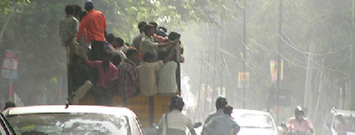Global Road Safety
 Whether you're on the road at home or abroad, know the risks and take steps to protect your safety.
Whether you're on the road at home or abroad, know the risks and take steps to protect your safety.
The Reality Around the World
 Throughout the world, roads are bustling with people operating cars, buses, trucks, motorcycles, and mopeds; with pedestrians; and with other types of travelers. Travel made possible by motor vehicles supports economic and social development in many countries and makes transporting goods and people fast and easy. Despite these benefits, however, motor vehicles are involved in crashes that are responsible for millions of deaths and injuries every year worldwide.
Throughout the world, roads are bustling with people operating cars, buses, trucks, motorcycles, and mopeds; with pedestrians; and with other types of travelers. Travel made possible by motor vehicles supports economic and social development in many countries and makes transporting goods and people fast and easy. Despite these benefits, however, motor vehicles are involved in crashes that are responsible for millions of deaths and injuries every year worldwide.
Consider the following:
- Globally, every year, about 1.3 million people are killed in motor vehicle crashes and 20–50 million more are seriously injured.
- Half of those people killed in crashes, globally, are pedestrians, motorcyclists, and cyclists.
- By 2020, motor vehicle crashes are expected to become the third most serious threat to human health in the world.
- Road traffic crashes are the world's leading cause of death for individuals between the ages of 15 and 29 years.
- Road traffic and transport accidents at work account for a high proportion of total roadway fatalities in the European Union—41% in 1999.
Steps for Safety At Home and Abroad
Motor vehicle crashes are a public health concern both abroad and in the United States. Crashes are a leading cause of death for Americans of all ages. More than 3 million people in the United States are treated in emergency departments for crash-related injuries each year. More than 40,000 die as a result of their injuries. These injuries and deaths are preventable.
 Whether you're a driver, passenger, cyclist, or pedestrian in the United States or abroad, take the following steps to stay safe on the road:
Whether you're a driver, passenger, cyclist, or pedestrian in the United States or abroad, take the following steps to stay safe on the road:
- Remember to always buckle up. Wearing your seat belt can reduce your risk of dying in a crash by about half.
- Make sure your young passengers are buckled into appropriate safety seats.
- Transport children in the back seat of your vehicle.
- If you have a teenage driver, sign an agreement with your teen to limit his or her risky driving, such as having multiple passengers and driving at night.
- Avoid drinking before driving, even in small amounts.
- Avoid activities that distract you from driving, like texting or talking on a cell phone.
Global Road Safety & CDC
The Centers for Disease Control and Prevention (CDC)'s Injury Center works to raise awareness of the issues that put motorists, motorcyclists, cyclists, and pedestrians in harm's way.
The following resources can help you learn more about CDC's work in motor vehicle safety:
- Motor Vehicle Safety
- Global Road Safety
- Child Passenger Safety
- Impaired Driving
- Teen Drivers
- Protect the Ones You Love: Road Traffic Injuries
- Parents Are the Key: CDC Campaign for Safe Teen Driving
- Task Force on Community Preventive Services and the Community Guide: Motor Vehicle Occupant Safety
- Podcasts on Motor Vehicle Safety
More Information
Get email updates
To receive email updates about this page, enter your email address:
Contact Us:
- Centers for Disease Control and Prevention
1600 Clifton Rd
Atlanta, GA 30333 - 800-CDC-INFO
(800-232-4636)
TTY: (888) 232-6348 - Contact CDC-INFO



